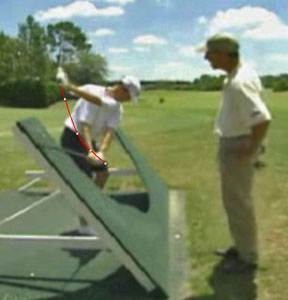
7-5 (Plane Line)

The above pic shows what the 'machine' at its base form looks like. The principles of this machine are the same as somebody properly swinging along a plane board.

If you look at the top diagram, it shows where the plane line is. It is the line at the bottom of the plane board. The club should point at the plane line throughout the swing (except when the clubshaft is parallel to the ground). This Martin Hall video basically explains having a 'straight plane line' with the SmartStick Training Aid.
We talk about 'swinging left' here in accordance to D-Plane, but all that means is keeping the face square to the target at impact and just 'moving the plane board' only a couple of degrees or so to the left and swinging along that 'imaginary plane board.'
But the thing to remember here is that the plane line and the line of flight of the ball are not always the same. 'Swinging Left' in accordance to D-Plane shows that. The same could be said if the golfer wants to hit a draw or a fade. The plane line has to be left of the clubface angle at impact for a fade and right of the clubface angle at impact for a draw. How you move the plane line will be discussed when I translate Chapter 10.
7-6 (Basic Plane Angles)
Basic Plane Angles are essentially the 'flatness' or the 'steepness' of the backswing.


As you can see, Mr. Hogan and Mr. Nicklaus have different looking backswings because they swing on different plane angles. But obviously neither is 'wrong' or 'better', just better for their bodies, abilities, and skills.
No Plane is technically too flat or too steep unless it allows the Heel or Toe of the Club to touch the ground before Seperation or without compensating. Ball location and Plane Angle are closely associated. As the Plane Angle steepens, the Ball must moved forward to control Divot depth. Never TRY to 'take' -- or 'not take' -- a Divot. It must be the automatic result of Ball Placement AND Plane Angle.
7-7 (Plane Angle Variations)
Plane Angle Variations is sort of like Jim Hardy's 'one plane' and 'two plane' swing, although I'm not a fan of the way Hardy simplifies it, nor the amount of importance he places upon it. In TGM, plane angle variations can be things like a 'zero shift', a 'single shift', a 'double shift', etc. Very few golfers can swing right along a large plane board. Instead, they usually will naturally 'lift' their hands and arm above the imaginary plane board and then they might drop them back on the imaginary plane board on the downswing.
3JACK
No comments:
Post a Comment